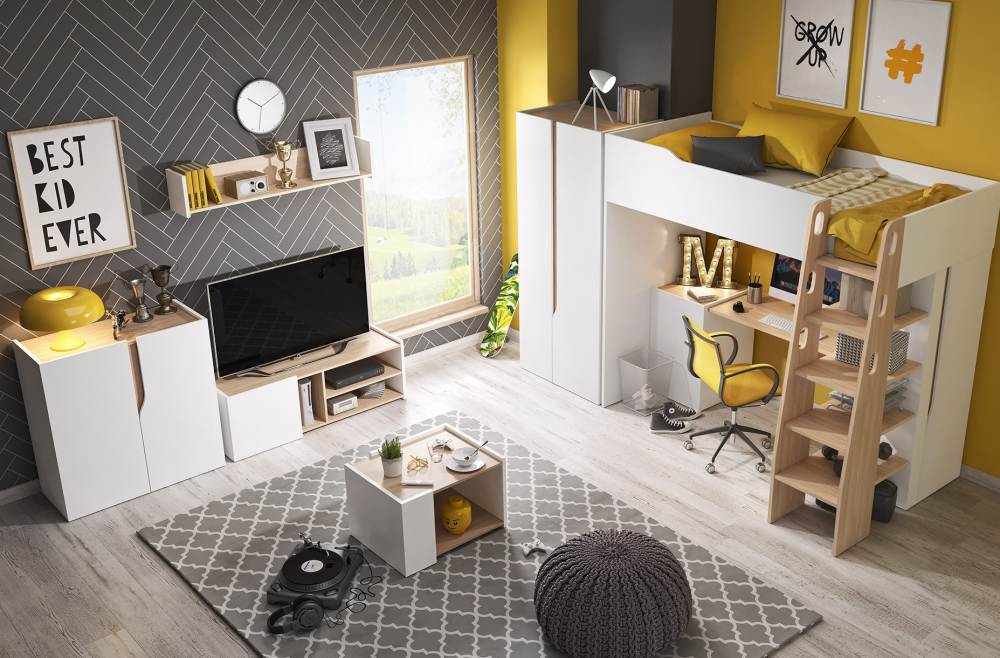INSPIRATIONS

How to choose a bed for a child
Once out of a cot around the age of two, a child often moves to a toddler bed, a transitional step between an infant sleeping and a full-sized bed. Many toddlers also go straight to a ‘’big bed”, which, considering how quickly children grow, might be a wise financial decision.
Mattress
The mattress is important. Although children might not complain of sore backs like adults do, their growing bones need a good support. A child’s spine can extend by as much as half an inch in a night – to avoid unnecessary strain and allow for growth without restrictions, neck and spine should be in a neutral position, and the mattress soft enough to be comfortable yet hard enough to provide support without sinking in. Sprung mattresses are better than thin foam, and a pocket sprung mattress, although the most expensive, provide the best support and comfort. For a child’s bed, an open-coil sprung mattress will be usually adequate. Memory foam mattresses reduce tossing and turning, while a latex mattress, the most expensive option, is breathable, durable and eco-friendly. Remember that a mattress should be changed every 10 years at the minimum, and for children, every five years.
Design options
Many of the children’s bed choices offer great space-saving solutions, and some are simply fun!
A standard single bed. This is easy to get in and out from, and will make changing the bed linen significantly easier than other options. A full sized standard bed frame can serve your child for a long time, even into their teenage years (with a new mattress), so it makes sense to invest into a good quality, sturdy design.
Solid wood frames maintain their looks for longer than veneered ones, and can be refreshed with stains or paint. Simple metal frames tend to have a slightly institutional look, but can offer great value for money, while others come in interesting designs. Look out for the quality of welding and possible sharp angles.
A divan bed (a mattress placed on a box spring base) is a time-honoured traditional design, and the base can contain drawers for extra storage of bedding or toys.
A mid sleeper has loads of storage space underneath. The space under a mid-sleeper can be also used for play, often featuring a tent.
A cabin bed (sometimes known as a captain’s bed) has a compact, attractive look, and storage underneath. Some have a trundle bed on coasters that can be pulled out for a sleepover guest.
A high sleeper is a fantastic space saving solution, with enough space underneath to fit a lot of storage or a desk. This is ideal for small rooms, though if the ceiling is low, it might get stuffy up there. A high sleeper needs a safety ladder and guard rails on both sides.
Children love bunk beds! And if two share a room, a bunk bed will save a lot of floor space needed for other furniture or simply for playing. Some bunk beds allow for splitting into two singles, which can prolong their life into the kids’ teenage years (as most teens are not as keen on bunks) or allow for reusing in spare or guest rooms. Remember that top bunks on a bunk bed or high sleepers are not recommended for kids under six years old.
Consider also
For the youngest children, beds that are closer to the ground and/or equipped with guard rails will protect them from injury and falling out. Guard rails are an absolute must for higher beds, including mid-sleepers and bunk beds, regardless of the age of the child: and that includes on the wall side, to avoid serious injury in case a child slips through the space between the bed and the wall.
Make sure that the mattress fits well in the frame, to avoid trapped feet or fingers.
High sleepers and bunk beds offer space savings and are great for bigger families and smaller houses, but changing bed linen on the top bunk can be VERY fiddly because of the combination of height and guard rails. Attending to a sick child in a bunk bed is also more difficult.
If the space is at premium, but you are not too keen on high-sleeping solutions, you might consider a so-called “small single”, with a standard length (fitting a 190cm mattress) but narrower (2ft 6in – 75cm rather than the standard 90cm wide). This is usually adequate for a child or young teen, but might become too cramped as they grow older. At the other end of the spectrum, a wide single (3ft 6in or 107cm) will give a lot of extra comfort, while still not taking up the space of a standard double.
